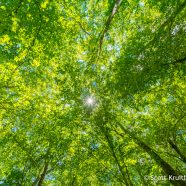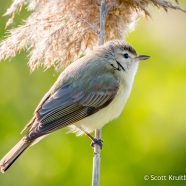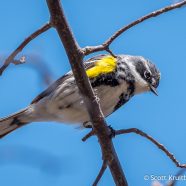Sun in the Forest
Happy Fourth of July weekend! We hope you enjoy the holiday and get outdoors for a hike under the beautiful summer tree canopy and bright sunshine. Find something new in the woods near you!
Read MoreWarbling Vireo
One of the more drab and plain May migrant birds in the Northeast is the Warbling Vireo (Vireo gilvus). Their subtle shades of brown, gray and olive combined with their tendency to hang up in the canopy makes it difficult to get an eyeful of the species – and you are far more likely to have an earful of their dynamic, fast and bold warbling song. This individual was foraging on a recent morning at a migratory hotspot, coming to eye-level and pausing on the phragmites just long enough for me to snap a shot. Scott Kruitbosch Conservation & Outreach Coordinator
Read MoreYellow-rumped Warbler
Here are a couple more stunning Yellow-rumped Warbler photos while they are looking so fantastic in their spring shades – and right before all the leaves pop out. They’ll be heading out soon as a greater diversity of warblers arrive in our backyards. I did see one unique Yellow-rumped Warbler yesterday that I will feature in an upcoming post… Scott Kruitbosch Conservation & Outreach Coordinator
Read MoreYellow-rumped Warbler
Here it is, the most abundant warbler you will likely see this year – the Yellow-rumped Warbler. In this case the bird was not showing off where it got that name, and instead it fluffed up and shook off for a moment while still watching for prey. There were plenty of flying (and biting!) insects already in the air here in late April, and it along with dozens of others had their fill flitting through the forest canopy. You can also see the leaves beginning to emerge. In a couple of weeks there will be a lot of green across the landscape and views like this one will already be covered...
Read MoreDeer Everywhere
One of the more concerning sightings to me as of late are all the White-tailed Deer tracks and signs that I keep finding. They should not be everywhere, in every habitat type, feeding on all sorts of plantings or ornamental greenery in the summer. The population is simply too high in too many areas across the Northeast. It is dangerous for us – via car accidents all the way to ticks – and for them, with increased contact with humans, disease and starvation. If they cannot find the proper food now then what will happen during the winter? This is not even going into how much damage...
Read More








